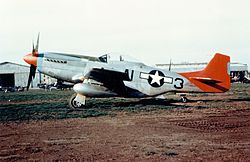Military service

He was a pilot with the 99th Fighter Squadron, 332nd Fighter Group for five years. [4]
James Clayton Flowers | |
|---|---|
| Born | December 25, 1915 Las Cruces, New Mexico, U.S. |
| Allegiance | United States of America |
| Branch | United States Army Air Force |
| Years of service | 1940–1945 |
| Rank | First Lieutenant |
| Unit | |
| Awards | Congressional Gold Medal awarded to the Tuskegee Airmen |
| Spouse | Evelyn Lorraine Flowers (m. 1951;died 2008) |
| Other work | Teacher in New York City |
James Clayton Flowers (born December 25, 1915) is an American retired military pilot who served with the Tuskegee Airmen during World War II.
James Clayton Flowers was born on December 25, 1915 [1] in Las Cruces, New Mexico. [2]

He was a pilot with the 99th Fighter Squadron, 332nd Fighter Group for five years. [4]
After the war, he and his wife Evelyn started a family. Flowers worked as a schoolteacher in The New York School System. After retirement, he and his wife relocated to New Mexico. [1] They had two children. [5] New Mexico held a ceremony to honour the Tuskegee Airmen in March 2014. Flowers was present for the dedication at the New Mexico Veterans' Memorial. [6] He turned 100 on December 25, 2015. [7]